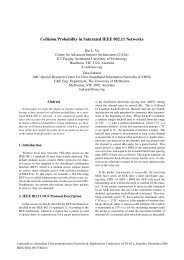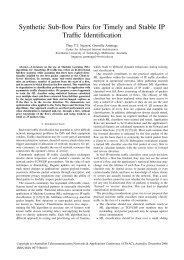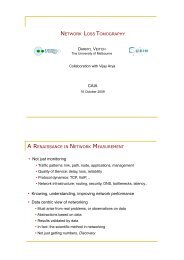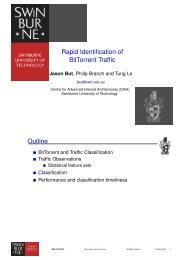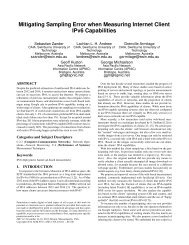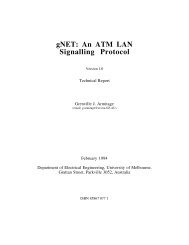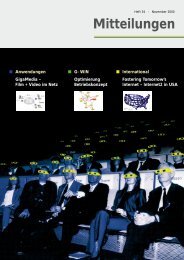Chapter 3 Time-to-live Covert Channels - CAIA
Chapter 3 Time-to-live Covert Channels - CAIA
Chapter 3 Time-to-live Covert Channels - CAIA
You also want an ePaper? Increase the reach of your titles
YUMPU automatically turns print PDFs into web optimized ePapers that Google loves.
Capacity (bits/packet)<br />
1.00<br />
0.95<br />
0.90<br />
0.85<br />
CHAPTER 3. TIME-TO-LIVE COVERT CHANNELS<br />
MED BSC<br />
MED BAC(1/5)<br />
MED BAC(1/10)<br />
MED BAC(1/50)<br />
MED BAC(1/100)<br />
1 2 3 4 5 6<br />
Amplitude A<br />
AMI BSC<br />
AMI BAC(1/5)<br />
AMI BAC(1/10)<br />
AMI BAC(1/50)<br />
AMI BAC(1/100)<br />
Figure 3.8: Capacity of BSC and BAC with varying degree of asymmetry for the MED and<br />
AMI modulation schemes (average error rate across all traces)<br />
• deletions of bits caused by loss of overt packets and<br />
• bit substitution errors caused by reordering of overt packets.<br />
The noise caused by modification of the TTL field on the path between covert sender<br />
and receiver and path changes (see Section 3.1) causes bit substitutions on the channel.<br />
Whether the TTL noise is symmetric or asymmetric depends on the modulation technique<br />
and the error probability distribution.<br />
We model the channel with only TTL noise either as binary symmetric channel (BSC)<br />
[22] or binary asymmetric channel (BAC) [169]. The BSC is a channel with two in-<br />
put/output symbols where each input symbol is changed <strong>to</strong> the other with error probabil-<br />
ity p. The BAC has two input/output symbols where the first symbol is changed <strong>to</strong> the<br />
second with probability a and the second symbol is changed <strong>to</strong> the first with probability b.<br />
However, the capacity difference of BSC and BAC is small even for larger asymmetries<br />
given the typically relatively small TTL error rates.<br />
The overall error rate of BAC and BSC is identical when p = a+b<br />
2 . If x defines the<br />
degree of asymmetry then a = 2p · x and b = 2p(1 − x). Figure 3.8 shows an example of<br />
the capacity of BSC and BAC with varying x for the MED and AMI modulation schemes<br />
averaged across all traces (see Section 3.5.2). The capacity difference between BSC and<br />
BAC is less than 0.03 bits per overt packet or packet pair, even for higher asymmetries<br />
than observed across all experiments. Also, the capacity of the BSC is always a lower<br />
bound for the capacity of the BAC. Therefore, we use the simpler BSC.<br />
How <strong>to</strong> model the impact of packet loss and reordering on the channel depends on<br />
whether the overt traffic supports the detection and/or correction of packet loss and re-<br />
ordering (e.g. retransmissions), assuming the related pro<strong>to</strong>col information (e.g. sequence<br />
48



